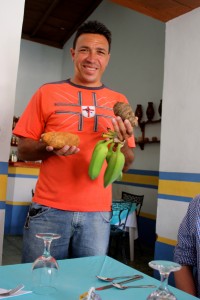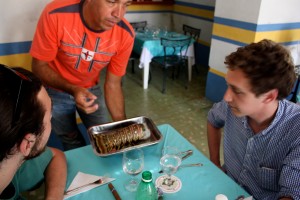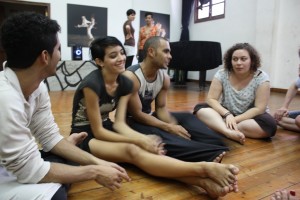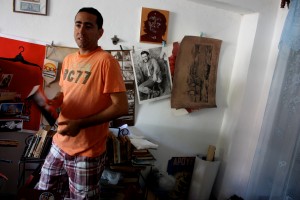The Not-So-Perfect World of the Cuban Artist
March 26, 2012 by ismoore
When I first learned that art education is funded by the Cuban Ministry of Culture and students who study dance, music, theater, and visual arts are guaranteed a job as a teacher or professional artist, I thought: wow, the U.S has a lot to learn from Cuba. American states are cutting art classes from school budgets, but even in the darkest hour of the Special Period, Cuba found a way to set aside money for art programs. However, as I interacted with a variety of Cuban artists and ex-artists, I saw that this picture-perfect art world is more sullied, multi-dimensional, and complicated than I originally thought. At a certain point in his or her life, a Cuban artist must sacrifice a state-funded job in the art industry in order to live a relatively comfortable life.
Working solely as a professional Cuban artist is simply unsustainable. Of course there are exceptional cases for those who make it to the top, internationally-recognized ranks of the art world, but this is not the majority of Cuban musicians, dancers, painters, sculptors, and performers. One young dancer we spoke to on our visit to the Rosario Cárdenas dance troupe in Havana is only paid $10/month. She is only 19 years-old and lives with a full household of working family members helping to support her, so she is able to get along with this meager salary. She still eats very little, despite the enormous amount of energy she burns during each grueling work day, but she knows that these meal portions would be even slighter if she was completely reliant on her own wages. The hours are demanding, from early in the morning to late at night everyday, and dance students do not have time to work another job outside of the troupe. What keeps her committed? Her passion for dance and movement is enough at this point. When she performed for us, fervor emanated from every limb, each of her muscles straining with dedication to the art, and the intensity of her movement was further amplified by her intimate relationship with her dance partner. But this emotional and physical attachment to dance may not be enough as she grows up and begins supporting herself financially.
I began to understand her wariness about her future as a dancer when, in some of the most unexpected situations, I encountered a variety of middle-aged ex-artists. Along the crowded Paseo del Prado in Cienfuegos, a 30-something year-old man named Anabel Ponce Nunez runs a private book-selling business. He was once a professional actor, but he reached the point in his life about a year ago when he had to “choose between survival and passion.” He opened up this small store in the front of his aunt’s home 5 months ago and has since then been able to make more money than he did as a state-funded actor. As Anabel spoke of the rising necessity to start working in the private sector and of connecting with tourists to acquire access to the Cuban convertible peso (CUC), two customers stopped by and bought an English language workbook. A few moments later, a young man came to purchase a Spanish-French dictionary. Anabel explained that these men were likely looking to begin work in the tourist industry, as state jobs are becoming less and less sustainable. His explanation of his own decision to abandon acting cast a dimmer light on state-funded art careers in Cuba.
In a cool, yellow and blue-painted, concrete-walled Paladar in Trinidad, an ex-entertainer served us fresh red tomatoes, chicken fried in rum and honey, plantains and oozy flan. When we began asking him about life in Cuba, he reiterated the words of the Cienfuegos bookstore owner. Edel Hernandez Montero opened “Wakey Wakey and Shakey Shakey” a few years ago when he needed a higher income to support both him and his wife; he wasn’t able to do so comfortably with a state salary. He loved entertaining, but the adrenalin-fueled satisfaction of pleasing a crowd could not take precedence over his basic needs. He left his job and devoted himself to giving customers the best possible dining experience. His little restaurant is kept in spotless condition, with carefully placed decorations (olive oil bottles colorfully infused with red chilli peppers and basil), and the writing on the menu looked as though it had been meticulously perfected down to every last squiggle. As he continually assured us he would do his best to make our meal at his paladar a memorable one, even going so far as to show us the fresh ingredients we were about to eat before cooking them, I saw that by forsaking one art, Cubans are learning to master a new one: customer service.

Edel Montero shows us the fresh ingredients that made up our meal at "Wakey Wakey and Shakey Shakey" paladar in Trinidad.

Edel tries to entice us to come back for dinner, when he planned to serve this freshly-caught lobster.
While the Cuban government’s commitment to the arts industry is impressive and worth learning from, the story of the Cuban artist is not as ideal as it may seem from afar. With the rise of the private sector and the tourist industry, many Cubans are forced to give up their state-funded work in the art world in order to secure a more prosperous livelihood.
Leave a Reply
You must be logged in to post a comment.



